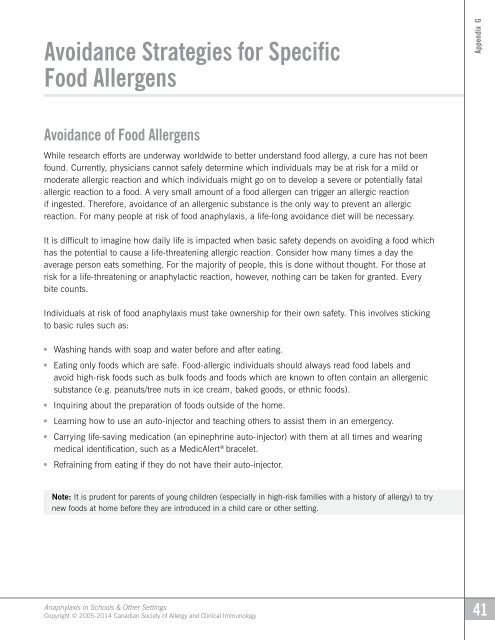Anaphylaxis in Schools 3rd Edition
Anaphylaxis in Schools 3rd Edition
Anaphylaxis in Schools 3rd Edition
Create successful ePaper yourself
Turn your PDF publications into a flip-book with our unique Google optimized e-Paper software.
Avoidance Strategies for Specific<br />
Food Allergens<br />
Appendix G<br />
Avoidance of Food Allergens<br />
While research efforts are underway worldwide to better understand food allergy, a cure has not been<br />
found. Currently, physicians cannot safely determ<strong>in</strong>e which <strong>in</strong>dividuals may be at risk for a mild or<br />
moderate allergic reaction and which <strong>in</strong>dividuals might go on to develop a severe or potentially fatal<br />
allergic reaction to a food. A very small amount of a food allergen can trigger an allergic reaction<br />
if <strong>in</strong>gested. Therefore, avoidance of an allergenic substance is the only way to prevent an allergic<br />
reaction. For many people at risk of food anaphylaxis, a life-long avoidance diet will be necessary.<br />
It is difficult to imag<strong>in</strong>e how daily life is impacted when basic safety depends on avoid<strong>in</strong>g a food which<br />
has the potential to cause a life-threaten<strong>in</strong>g allergic reaction. Consider how many times a day the<br />
average person eats someth<strong>in</strong>g. For the majority of people, this is done without thought. For those at<br />
risk for a life-threaten<strong>in</strong>g or anaphylactic reaction, however, noth<strong>in</strong>g can be taken for granted. Every<br />
bite counts.<br />
Individuals at risk of food anaphylaxis must take ownership for their own safety. This <strong>in</strong>volves stick<strong>in</strong>g<br />
to basic rules such as:<br />
• Wash<strong>in</strong>g hands with soap and water before and after eat<strong>in</strong>g.<br />
• Eat<strong>in</strong>g only foods which are safe. Food-allergic <strong>in</strong>dividuals should always read food labels and<br />
avoid high-risk foods such as bulk foods and foods which are known to often conta<strong>in</strong> an allergenic<br />
substance (e.g. peanuts/tree nuts <strong>in</strong> ice cream, baked goods, or ethnic foods).<br />
• Inquir<strong>in</strong>g about the preparation of foods outside of the home.<br />
• Learn<strong>in</strong>g how to use an auto-<strong>in</strong>jector and teach<strong>in</strong>g others to assist them <strong>in</strong> an emergency.<br />
• Carry<strong>in</strong>g life-sav<strong>in</strong>g medication (an ep<strong>in</strong>ephr<strong>in</strong>e auto-<strong>in</strong>jector) with them at all times and wear<strong>in</strong>g<br />
medical identification, such as a MedicAlert ® bracelet.<br />
• Refra<strong>in</strong><strong>in</strong>g from eat<strong>in</strong>g if they do not have their auto-<strong>in</strong>jector.<br />
Note: It is prudent for parents of young children (especially <strong>in</strong> high-risk families with a history of allergy) to try<br />
new foods at home before they are <strong>in</strong>troduced <strong>in</strong> a child care or other sett<strong>in</strong>g.<br />
<strong>Anaphylaxis</strong> <strong>in</strong> <strong>Schools</strong> & Other Sett<strong>in</strong>gs<br />
Copyright © 2005-2014 Canadian Society of Allergy and Cl<strong>in</strong>ical Immunology<br />
41


